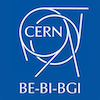The IFMIF accelerator will accelerate two 125 mA continuous wave (cw) deuteron beams up to 40 MeV and blasts them onto a liquid lithium target to release neutrons. The very high beam power of 10 MW pose unprecendented challenges for the accelerator development. Therefore, it was decided to build a prototype accelerator, the Linear IFMIF Prototype Accelerator (LIPAc), which has the very same beam characteristic, but is limited to 9 MeV only. In the frame of this thesis, diagnostics devices for IFMIF and LIPAc have been developed. The diagnostics devices consist of beam loss monitors and interceptive as wellnon-interceptive profile monitors. For the beam loss monitoring system, ionization chambers and diamond detectors have been tested and calibrated for neutron and γ radiation in the energy range expectedLIPAc. During these tests, for the first time, diamond detectors were successfully operated at cryogenic temperatures. For the interceptive profilers, thermal simulations were
performed to ensure safe operation. For the non-interceptive profiler, Ionization Profile Monitors (IPMs) were developed. A prototype has been built and tested, and based on the findings, the final IPMs were designed and built. To overcome the space chargeaccelerator beam, a software algorithm was written to reconstruct the actual beam profile.
Mariusz Sapinsk... on
- to post comments
